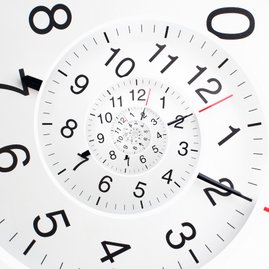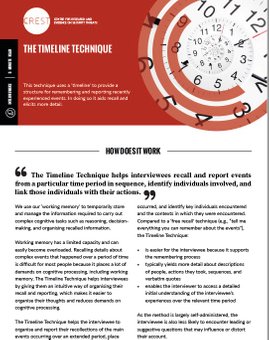Timeline Technique
The Timeline Technique is a self-administered reporting format that uses a ‘timeline’ to provide a structure for remembering, and has been developed to respond to particular challenges in eliciting information about complex or extended events.
Our research shows that this innovative format helps interviewees recall and report events from a particular time period in the order in which they occurred, identify individuals involved, link those individuals with their actions by mapping out the timeline in which they happened. This technique has been extended via additional research to incorporate additional tools and target different types of information (e.g. what was said and who said it).
You can read more about the Timeline Technique in our published research (see below) and via the CREST website.
Original Article
Hope, L., Mullis, R. & Gabbert, F. (2013). Who? What? When? Using a timeline technique to facilitate recall of a complex event. Journal of Applied Research in Memory and Cognition, 2, 20-24.
Abstract
Accurately recalling a complex multi-actor incident presents witnesses with a cognitively demanding retrieval task. Given the important role played by temporal context in the retrieval process, the current research tests an innovative timeline technique to elicit information about multiple perpetrators and their actions. Adopting a standard mock witness paradigm, participants were required to provide an account of a witnessed event. In Experiment 1, the timeline technique facilitated the reporting of more correct details than a free recall, immediately and at a two-week retention interval, at no cost to accuracy. Accounts provided using the timeline technique included more correct information about perpetrator specific actions and fewer sequencing errors. Experiment 2 examined which mnemonic components of the timeline technique might account for these effects. The benefits of exploiting memory organization and reducing cognitive constraints on information flow are likely to underpin the apparent timeline advantage.
Highlights
- Accurately recalling a complex multi-actor incident presents witnesses with a cognitively demanding retrieval task.
- Adopting a mock witness paradigm, we tested an innovative timeline technique to elicit information about a complex crime.
- The timeline technique facilitated reporting of more correct details than a free recall, at no cost to accuracy, both immediately and after a delay.
- Timeline reports included more correct information about perpetrator specific actions and fewer incident sequencing errors.
- Exploiting memory organization and reducing constraints on information flow may underpin the apparent timeline advantage.
Recent Articles on the Timeline Technique
Hope, L., Gabbert, F., Kinninger, M., Kontogianni, F., Bracy, A. l., & Hanger, A. (2019). Who said what and when? Development and testing of a timeline approach to eliciting information and intelligence about conversations, plots and plans. Law and Human Behavior. DOI: 10.1037/lhb0000329
Abstract
The verbal content of interactions (what was said and who said what) can be important as evidence and intelligence information. Across 3 empirical studies, we examined memory for details of an overheard (Experiment 1) or witnessed (Experiments 2 and 3) conversation using a timeline technique adapted for the reporting of conversations between multiple speakers. Although participants in all conditions received the same general instructions, participants assigned to timeline reporting format reported more verbatim information and made fewer sequencing errors than those using a free recall format. In Experiments 2 and 3, using an extended version of the technique, participants using the timeline reporting format also reported more correct speaker attributions and provided more information about the individuals involved, without compromising overall accuracy rates. With a large effect size across experiments (total N = 134), these findings suggest that timeline reporting formats facilitate the reporting of episodic memories and benefit the reporting of conversations.
Kontogianni, F., Hope, L., Taylor, P. J., Vrij, A., & Gabbert, F. (2018). The benefits of a self-generated cue mnemonic for timeline interviewing. Journal of Applied Research in Memory and Cognition. DOI: 10.1016/j.jarmac.2018.03.006
Abstract
Obtaining detailed accounts from individuals who have witnessed complex events under challenging encoding conditions presents a difficulty for investigators. In the present research, participants (N = 132) reported their recall of an event witnessed under full or divided attention using a timeline reporting format. Extending the timeline technique to assess the relative performance of two additional mnemonics—self-generated cues (SGC) and other-generated cues (OGC)—participants provided an account across three timeline reporting conditions comparing the efficacy of SGC, OGC, and no cues (control). Mock-witnesses using SGC provided more correct details than mock-witnesses in the OGC or no-cues conditions, under full but not under divided attention conditions. There was no difference between cue conditions with respect to the number of errors reported across attention conditions. Findings show SGC to be a promising addition to interviewing techniques as a retrieval support mnemonic with implications for applied contexts.

